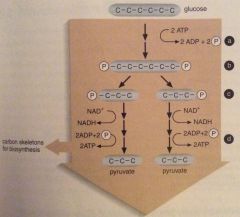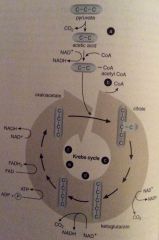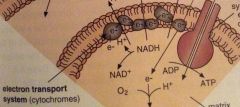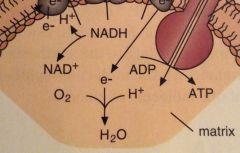![]()
![]()
![]()
Use LEFT and RIGHT arrow keys to navigate between flashcards;
Use UP and DOWN arrow keys to flip the card;
H to show hint;
A reads text to speech;
24 Cards in this Set
- Front
- Back
- 3rd side (hint)
|
Synthesis
|
reactions that involve the build-up of complex compounds
|
2. consumes energy
|
|
|
Biosynthesis
|
reactions combining small, simple organic molecules to form complex compounds
|
EX: proteins built from amino acids
|
|
|
Decomposition
|
reactions that break down organic molecules to simpler forms
|
1. opposite of synthesis
2. releases energy |
|

Cell Respiration
|
pathway of decomposition; provides energy cells need to function
|
1. series of reactions that releases energy as substances are broken down to CO(2) and H(2)O
|
|

Aerobic
|
O(2) is the oxidizing agent that receives e- from the decomposed substrates
|
1. occurs in presence of O(2)
|
|
|
Anaerobic
|
substrate may be only partly decomposed, which releases less energy, or O(2) is substituted with a nitrogen or sulfur compound
|
1. occurs without O(2)
|
|
|
Fermentation
|
occurs when O(2) is absent; releases energy during the breakdown of sugars
|
1. forms lactic acid, ethyl alcohol, acetic acid, other incompletely oxidized compounds
|
|

Glycolysis
|
enzymes partially oxidize glucose and split it into 2 3-carbon molecules
|
1. first stage of aerobic respiration and fermentation
2. glyco=sugar, lysis=loss or release: glycolysis= breakdown of sugar (glucose) |
|

Krebs Cycle
|
the resulting 2-carbon molecules, after glycolysis is completed, are oxidized completely to CO(2)
|
1. 2nd stage of aerobic respiration
|
|

ETS (e- Transport System)
|
regenerates supply of NAD+; transfers protons and e- to O(2), forming water; synthesizes most of the ATP
|
1. 3rd stage of aerobic respiration
|
|
|
NADH & FADH2
|
both formed in Krebs cycle; carry hydrogen ions (protons) and e- to the ETS; at the end of ETS, they reduce O(2) to form water
|
1. reduced forms of NAD+ and FAD
2. NADH acts as a carrier of reducing power |
|
|
Pyruvic Acid
|
3-carbon compound formed when enzymes catalyze the rearrangement and partial oxidation of glucose sugar-phosphates
|
1. pyruvate needs O(2) to survive
|
|
|
Pyruvate
|
a result when pyruvic acid is oxidized, which leads to the reduction of NAD+
|
1. needs O(2) to survive
|
|
|
Lactate/Lactic Acid
|
converted form of NADH and pyruvate; reversed oxidation that produced pyruvate
|
1. 3-carbon acid
2. formed when insufficient O(2) is present |
|
|
Alcoholic (Fermentation)
|
yeast and some bacteria breakdown pyruvate to ethanol and acetic acid
|
1. anaerobic pathway
|
|
|
Lactic Acid (Fermentation)
|
NAD+ cycles to glycolysis, which continues to provide a small amount of ATP until more oxygen is available
|
1. anaerobic pathway
|
|

Mitochondrion
|
organelles that the Krebs cycle and ETS occur in
|
1. known as the powerhouses of the cell because they are the sites where most ATP is synthesized
|
|

Matrix
|
fluid-filled interior space of a mitochondrion
|
1. contains most of the enzymes of the Krebs cycle
|
|
|
Cristae
|
many folds of the inner membrane that extend into the inside of the mitochondrion
|
1. enzymes of the ETS are organized in and on the cristae
|
|
|
Cytochromes
|
proteins in the ETS; embedded in the inner membranes of mitochondria; transfer e- step by step through the ETS
|
1. cyto= cell, chrome= color, cytochrome= components of cells that give them color
|
|
|
Faculative Aerobes
|
some bacteria that can survive for long periods with or without O(2)
|
1. able to switch back and forth between fermentation and aerobic respiration, depending on O(2) supply
|
|
|
Obligate Anaerobes
|
generate ATP entirely from fermentation or anaerobic respiration
|
1. poisoned by O(2)
EX: other types of bacteria |
|
|
Obligate Aerobes
|
can't survive for long without O(2)
|
EX: animals and plants
|
|

Hydrolysis
|
breakdown where the components of water, H and OH, are inserted into the bond to break it
|
EX: digestive glands supply enzymes to the stomach and intestines that break the bonds between neighboring amino acids until the protein is completely decomposed
|

